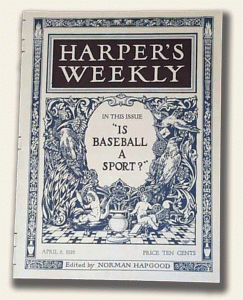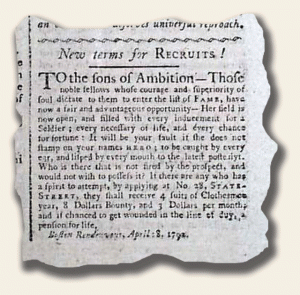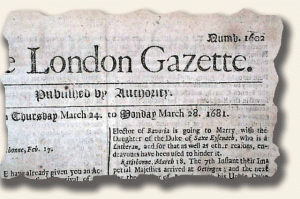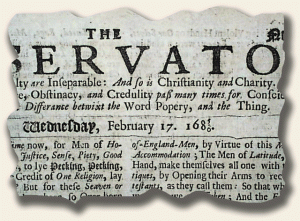Why does my newspaper look as if it came from a book?
April 30, 2009 by GuyHeilenman · Leave a Comment
 This is a common question many newcomers ask upon their 1st encounter with a rare newspaper from nearly every era (Revolutionary War, Civil War, Old West, and even Birthday/Day-You-Were-Born issues, to name a few). Whether it is the rough left spine present from the issue being removed from a larger volume, or the consecutive numbering which results in only the first issue printed during the year to have a “page 1”, a novice’s immediate (and logical) reaction is that the issue must have come from a book and therefore must be a reprint. However, the truth is actually the opposite. Such signs are good indicators that the issue is likely authentic. To understand this, what is needed is a knowledge of how historic newspapers and magazines were handled up to as late as the 1960’s.
This is a common question many newcomers ask upon their 1st encounter with a rare newspaper from nearly every era (Revolutionary War, Civil War, Old West, and even Birthday/Day-You-Were-Born issues, to name a few). Whether it is the rough left spine present from the issue being removed from a larger volume, or the consecutive numbering which results in only the first issue printed during the year to have a “page 1”, a novice’s immediate (and logical) reaction is that the issue must have come from a book and therefore must be a reprint. However, the truth is actually the opposite. Such signs are good indicators that the issue is likely authentic. To understand this, what is needed is a knowledge of how historic newspapers and magazines were handled up to as late as the 1960’s.
 Many publishers of early newspapers started numbering their pages from 1 at the start the year and continued with the consecutive numbering throughout the year. This made it very easy to reference content. Examples of early well-known titles which did this are Harper’s Weekly, The War, Gentleman’s Magazine, Niles’ Register, and Leslie’s Illustrated, to name a few. Although this gave the newspapers a book effect, early readers would not have given this another thought. As far as the spine residue/disbinding evidence (which gives the appearance that the issue came from a book) is concerned, nearly every institution which held rare newspapers bound them together at the end of each year for protection & permanent storage in libraries. Almost all newspapers through the 1960’s were held in this manner. Your local library likely holds its early newspapers in this form. Two resources which may alleviate any concerns you might have related to this issue are the Library of Congress’ Newspaper Division & the American Antiquarian Society. HistoryBuff.com also provided additional information regarding this topic.
Many publishers of early newspapers started numbering their pages from 1 at the start the year and continued with the consecutive numbering throughout the year. This made it very easy to reference content. Examples of early well-known titles which did this are Harper’s Weekly, The War, Gentleman’s Magazine, Niles’ Register, and Leslie’s Illustrated, to name a few. Although this gave the newspapers a book effect, early readers would not have given this another thought. As far as the spine residue/disbinding evidence (which gives the appearance that the issue came from a book) is concerned, nearly every institution which held rare newspapers bound them together at the end of each year for protection & permanent storage in libraries. Almost all newspapers through the 1960’s were held in this manner. Your local library likely holds its early newspapers in this form. Two resources which may alleviate any concerns you might have related to this issue are the Library of Congress’ Newspaper Division & the American Antiquarian Society. HistoryBuff.com also provided additional information regarding this topic.
Great reference work for pre-1821 American newspapers…
April 27, 2009 by TimHughes · Leave a Comment
 We are often asked about appropriate reference books for rare newspaper collectors, particularly when it comes to relative rarity of newspapers. When one encounters an early title not seen before, how can we judge how rare or common it might be?
We are often asked about appropriate reference books for rare newspaper collectors, particularly when it comes to relative rarity of newspapers. When one encounters an early title not seen before, how can we judge how rare or common it might be?
Thankfully for all collectors, Clarance Brigham undertook an exhaustive 30 year project to record all know issues of every newspaper title printed in the United States prior to 1821. This effort, published by the American Antiquarian Society (Brigham was directory of the Society) back in 1947, is titled: “History & Bibliography of American Newspapers 1690-1820“, a two volume set with some 1500 pages in total.
This work lists all American newspapers from the noted timespan, by state, then by city, then by title. The true value of this work is the brief historical account of each title with the exact dates of changes of titles & names of publishers, followed by a checklist of all files located. This last piece is what reflect relative rarity. If a title has just one or two holdings in institutions, and only a few issues within these institutions, then it would be consider rare. If a title has 15 institutional holdings noted, and complete or near complete holdings within those institutions, the title might be considered common.
This set has been out of print for many years, including the more recent edition done in 1975, but they occasionally come up on eBay or web-based rare book sites such as abebooks.com. Prices tend to run from $200 to $400 for a set, but a lucky person might find it for much less. I believe we have a set of the 1947 edition priced at $265.
I would encourage any collector of pre-1821 newspapers to think about adding this work to their reference library. It contains a wealth of information and is a resource which I have used regularly for over 30 years.
Responding to the patriotic call…
April 25, 2009 by TimHughes · Leave a Comment
 The Columbian Centinel newspaper from Boston, April 28, 1792 contains a very inconspicuous notice at the bottom of the front page which calls for recruits for the military. It’s the wording which is a delight, as the call was put forth:
The Columbian Centinel newspaper from Boston, April 28, 1792 contains a very inconspicuous notice at the bottom of the front page which calls for recruits for the military. It’s the wording which is a delight, as the call was put forth:
“To the sons of ambition—Those noble fellows whose courage and superiority of soul dictate to them to enter the list of Fame…Her field is now open and filled with every inducement for a Soldier; every necessary of life and every chance for fortune. It will be your fault if she does not stamp on your names HERO to be caught by every ear…” with more.
See the photo for the full text of this delightful little gem from the 18th century.
Twelve issues, twelves different cities…
April 23, 2009 by TimHughes · Leave a Comment
Occasionally one finds a single title which had two or maybe three cities of publication, particularly some of the Old West titles which moved from place to place during their early years. Even the venerable Gazette of the United States moved from New York to Philadelphia when the seat of government moved, in order to be close to the political action it was reporting.
 The Trans-Continental had a different take on printing in different cities. It’s creation was a stroke of historical genius in the mind of its editor, W. R. Steele, when on May 24, 1870 over 130 passengers boarded a beautiful eight car Pullman train built under special orders of George M. Pullman specifically for this trip, the first chartered excursion by rail from the Atlantic to the Pacific. On board was carried small printing press which was used to publish 12 issues of the “Trans-Continental” newspaper, each at a different point along the round-trip journey. By what is read in these twelve issues it was a glorious affair enjoyed by all, amid the splendor of the finest mode of living ever constructed on wheels.
The Trans-Continental had a different take on printing in different cities. It’s creation was a stroke of historical genius in the mind of its editor, W. R. Steele, when on May 24, 1870 over 130 passengers boarded a beautiful eight car Pullman train built under special orders of George M. Pullman specifically for this trip, the first chartered excursion by rail from the Atlantic to the Pacific. On board was carried small printing press which was used to publish 12 issues of the “Trans-Continental” newspaper, each at a different point along the round-trip journey. By what is read in these twelve issues it was a glorious affair enjoyed by all, amid the splendor of the finest mode of living ever constructed on wheels.
For their enjoyment, the passengers were lavished with the finest food, surrounded by a setting which few of the finest mansions constructed could rival. Sights of the new West as well as extraneous news & anecdotes of the day were recorded in the pages of this newspaper, witnessed by the passengers continually in awe of the splendor of the prairies, magnificence of the Rockies and the warmth & hospitality of the people they met along the way.
The Trans-Continental lasted but 42 days and twelve issues–six printed on the westward journey & six printed on the return to the east coast. What is unique is that each issue not only carries a different date but a different city of publication.
Unfortunately for the collector exceedingly few genuine issues of the Trans-Continental remain. Having a complete set in our private collection we had each issue professionally reproduced and bound into a SINGLE BOOKLET so any collector can read from one of the more intriguing & unusual newspapers of the 19th century.
You may never own an original but you can take some vicarious enjoyment in the trip by reading what those 130 passengers enjoyed nearly 140 years ago by clicking on the “single booklet” link above. After all, isn’t this what brought is all to the hobby in the first place?
The plight of newspapers & its impact on the hobby…
April 20, 2009 by TimHughes · 3 Comments
 In recent years–and to a greater degree recent months–we’ve been hearing about the demise of the newspaper, at least that edition which has appeared on newsstands & doorsteps for many generations. Much blame goes to the internet and our increasingly digital society, although the proliferation of cable news, now available 24 hours a day, shares in the blame as well.
In recent years–and to a greater degree recent months–we’ve been hearing about the demise of the newspaper, at least that edition which has appeared on newsstands & doorsteps for many generations. Much blame goes to the internet and our increasingly digital society, although the proliferation of cable news, now available 24 hours a day, shares in the blame as well.
For us hobbyists, who have collected the “hard copy” while they are still rolling off the presses across America, what will the impact be if print editions die off completely?
 If the past is any example I would suggest there will be heightened interest in collecting newspapers. Much of what is popular today in the collecting world are items which are now obsolete: phonograph records, old telephones, mustache cups, treadle sewing machines, and on and on. While one school of thought is that interest is heightened once an item is no longer produced, another thought is that collecting interest will fade when they are no longer produced. How many thousands of items which have faded from memory & long ago ceased production are not on the “radar” of collectors?
If the past is any example I would suggest there will be heightened interest in collecting newspapers. Much of what is popular today in the collecting world are items which are now obsolete: phonograph records, old telephones, mustache cups, treadle sewing machines, and on and on. While one school of thought is that interest is heightened once an item is no longer produced, another thought is that collecting interest will fade when they are no longer produced. How many thousands of items which have faded from memory & long ago ceased production are not on the “radar” of collectors?
Let hear of your thoughts. You are the collectors; your passion and holdings may well be impacted one way or the other if current newspapers cease publication. How do you think this could impact the hobby?
Wishful thinking…
April 18, 2009 by TimHughes · Leave a Comment
 The “Epitaph” shown in the photo is taken from the Columbian Centinel, Extra newspaper from Boston, Nov. 26, 1806. The graphic devises add a bit of charm to the simple–perhaps hopeful–thought:
The “Epitaph” shown in the photo is taken from the Columbian Centinel, Extra newspaper from Boston, Nov. 26, 1806. The graphic devises add a bit of charm to the simple–perhaps hopeful–thought:
“I John Gayre, am ready to swear,
That thought I lie here, I’m yet up there.”
Rare & early newspapers never cease to provide a bit of comic relief to the harsh edge of life. Enjoy!
Collection Spotlight: One man’s passion for pulp… From Antique Trader…
April 16, 2009 by GuyHeilenman · Leave a Comment
Joe Rainone, a member of the Rare & Early Newspapers Community, recently had a featured article in a post at AntiqueTrader.com. His passion is focused primary on pulp magazines, with some cross-over to collectible newspapers. The article begins:
 “My passion for collecting started in the mid 1980s although I did enjoy collecting stamps, coins and reading comics as a child. I started to collect comic books again with my 9-year-old son who loved Spider-Man. This was my introduction to popular fiction.
“My passion for collecting started in the mid 1980s although I did enjoy collecting stamps, coins and reading comics as a child. I started to collect comic books again with my 9-year-old son who loved Spider-Man. This was my introduction to popular fiction.
I became intrigued with pulp magazines. In time, I became more interested, not only in the artwork, but also the history of how and where it all began…”
To read more, go to http://www.antiquetrader.com/article/One_mans_passion_for_pulp. Great job Joe!
The rare newspaper community is pregnant with scores of members with their own collectible passion. One of the beauties of the hobby is the endless varieties of directions one’s collection can go. If you’d like to share about your collectible area of interest, please do.
Collectible Magazines… Rich West… Periodyssey – Part II
April 13, 2009 by GuyHeilenman · 1 Comment
Tammy Kahn Fennell at Collectibles Corner TV recently completed part II of her interview with Rich West of Periodyssey fame. Part II of the interview begins at the 3:32 mark; however, if you have the time, the entire episode is worth watching. Thanks Tammy… and Rich.
Episode #10 – Depression Glass, Colophon, Rich West of Periodyssey part 2, Get Me Video
Note from the previous post re: the interview with Rich:
Although Timothy Hughes Rare & Early Newspapers’ archives contain nearly every issue of Gentleman’s Magazine, Harper’s Weekly (actually an illustrated newspaper), Harper’s Monthly, The Sporting News, and a selection of others (Liberty Magazine, Atlantic Monthly, Scribner’s, etc.), including many of these and others beyond what is posted on the Rare & Early Newspapers website, the Timothy Hughes of magazine collecting is Rich West of Periodyssey. He operates with integrity, has an incredible inventory of magazines to offer, and is the most knowledgeable resource in the field of magazine collectibles.
Editorial policy (?) and the potential impact upon an issue’s collectibility…
April 11, 2009 by GuyHeilenman · Leave a Comment
The following are a few thoughts by Morris Brill (guest contributor) concerning slight differences in the printing of the Declaration of Independence within the London Chronicle (dated August 17, 1776) vs. the printing within the Gentleman’s Magazine (dated August, 1776):
Recently on Ebay two different sellers offered a printing of the Declaration of Independence in the Gentleman’s Magazine. I also noted your offering of the Declaration within the London Chronicle.
I (Morris) noted, while reading the text of Gentleman’s Magazine, as photographed on Ebay, a particular sentence in which two words were missing and substituted with a line, i.e. ___________
 The sentence is as follows:
The sentence is as follows:
“A prince, whose character is thus marked by every act which may define a tyrant, is unfit to be the ruler of a free people.”
In the Gentleman’s Magazine the words ” prince” and “tyrant” are deleted.
I find it interesting that although the Gentleman’s Magazine and the the London Chronicle are both British that one paper printed the words prince and tyrant, yet the other did not.
To me, the deletion of the two words certainly diminishes the historic value of the printing as it appeared in the Gentleman’s Magazine, although I would not pass up the opportunity to own this paper. Perhaps it has to do with an opposing editorial policy, or the political persuasion of the two publishers.
Morris
Note: If anyone is aware of the formal policy which led to the deletion of certain words within the Gentleman’s Magazine, please share your insight with the rare newspaper community.
Double-dated newspapers: the Julian and Gregorian calendars…
April 9, 2009 by TimHughes · 1 Comment
 If you have some 1600’s newspapers in your collection you may have a few with dates showing years as “1683/4″ or 1686/7”, or perhaps you have a few issues from a single year where a later date has an issue number lower than an earlier date, and you’ve wondered “how could this be?” Well, it’s due to the calendar, or more specifically which calendar was in use at the time.
If you have some 1600’s newspapers in your collection you may have a few with dates showing years as “1683/4″ or 1686/7”, or perhaps you have a few issues from a single year where a later date has an issue number lower than an earlier date, and you’ve wondered “how could this be?” Well, it’s due to the calendar, or more specifically which calendar was in use at the time.
Although the differences between the older Julian calendar and our current Gregorian calendar are many and very complicated and can be understood by visiting this site, the short answer is that in the latter part of the 17th century & a portion of the 18th century both calendars were in use in England, and the date of the issue would reflect which calendar was in use.
 The new year of the older Julian calendar began on March 21, so an issue dated March 17, 1675 would be followed by the next weekly issue dated March 24, 1676. This would also mean that an issue dated December 31, 1675 would be followed by an issue dated January 7,1675. This was how the London Gazette dated it’s issues for much of the 17th and early 18th centuries. At first glance one would think that the issue of Jan. 7, 1675 was older than one dated December 31, 1675, but the opposite was true.
The new year of the older Julian calendar began on March 21, so an issue dated March 17, 1675 would be followed by the next weekly issue dated March 24, 1676. This would also mean that an issue dated December 31, 1675 would be followed by an issue dated January 7,1675. This was how the London Gazette dated it’s issues for much of the 17th and early 18th centuries. At first glance one would think that the issue of Jan. 7, 1675 was older than one dated December 31, 1675, but the opposite was true.
 Other titles were a bit more helpful in noting the year of publication by dating issues from January 1 thru March 20 with a double-dated year such as “1684/5” or “1686/7” so the reader would know that it was from the year 1684 under the Julian calendar, or 1685 under the Gregorian calendar.
Other titles were a bit more helpful in noting the year of publication by dating issues from January 1 thru March 20 with a double-dated year such as “1684/5” or “1686/7” so the reader would know that it was from the year 1684 under the Julian calendar, or 1685 under the Gregorian calendar.
Some American newspapers of the 18th century have similar double dates, but by the beginning of the 19th century–if not reasonably before–newspapers had converted exclusively to the Gregorian calendar. The same was true with most of the Western world, while other portions of the globe adopted the Gregorian dating system much later.
Hopefully this answers a few questions you have had. Be in touch if we can be more helpful!


